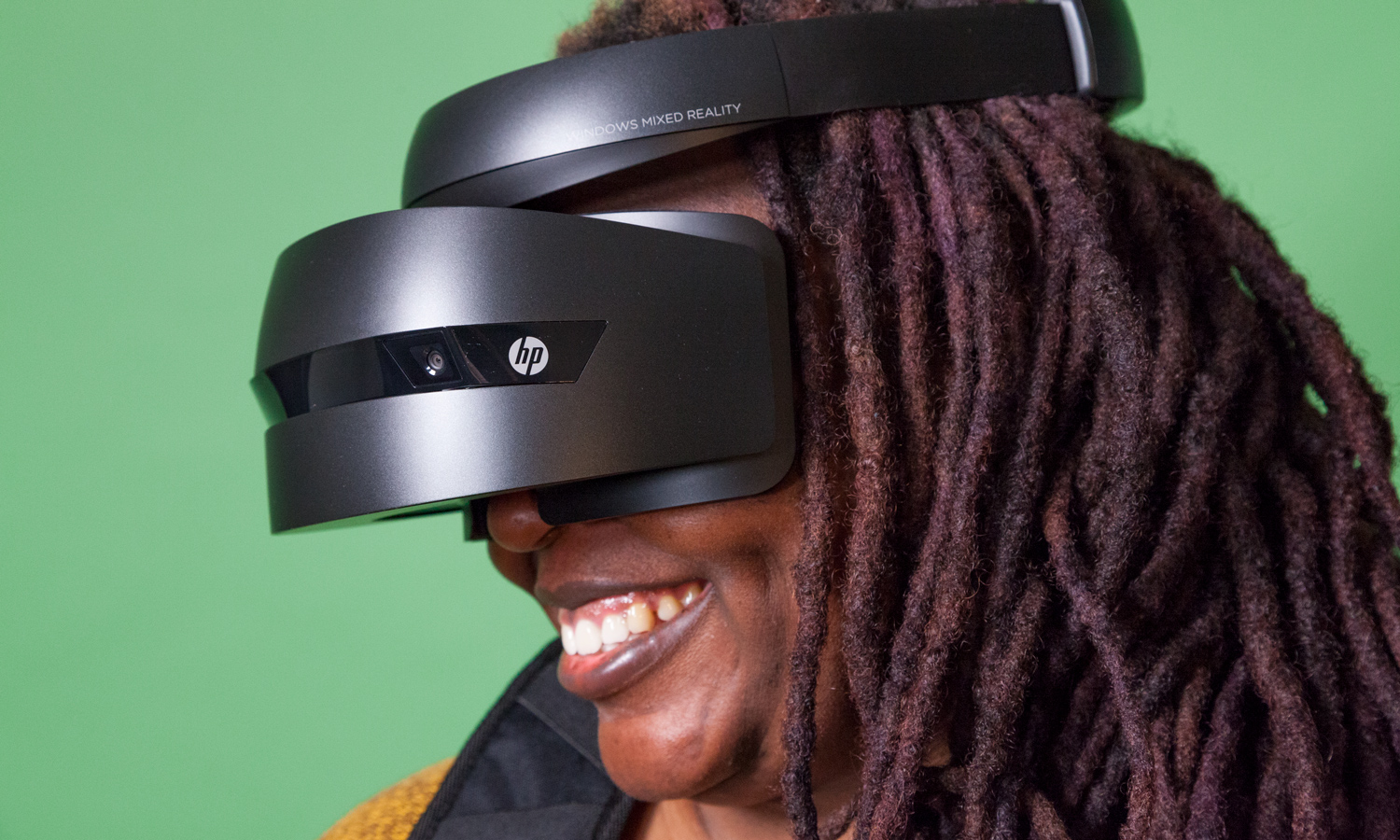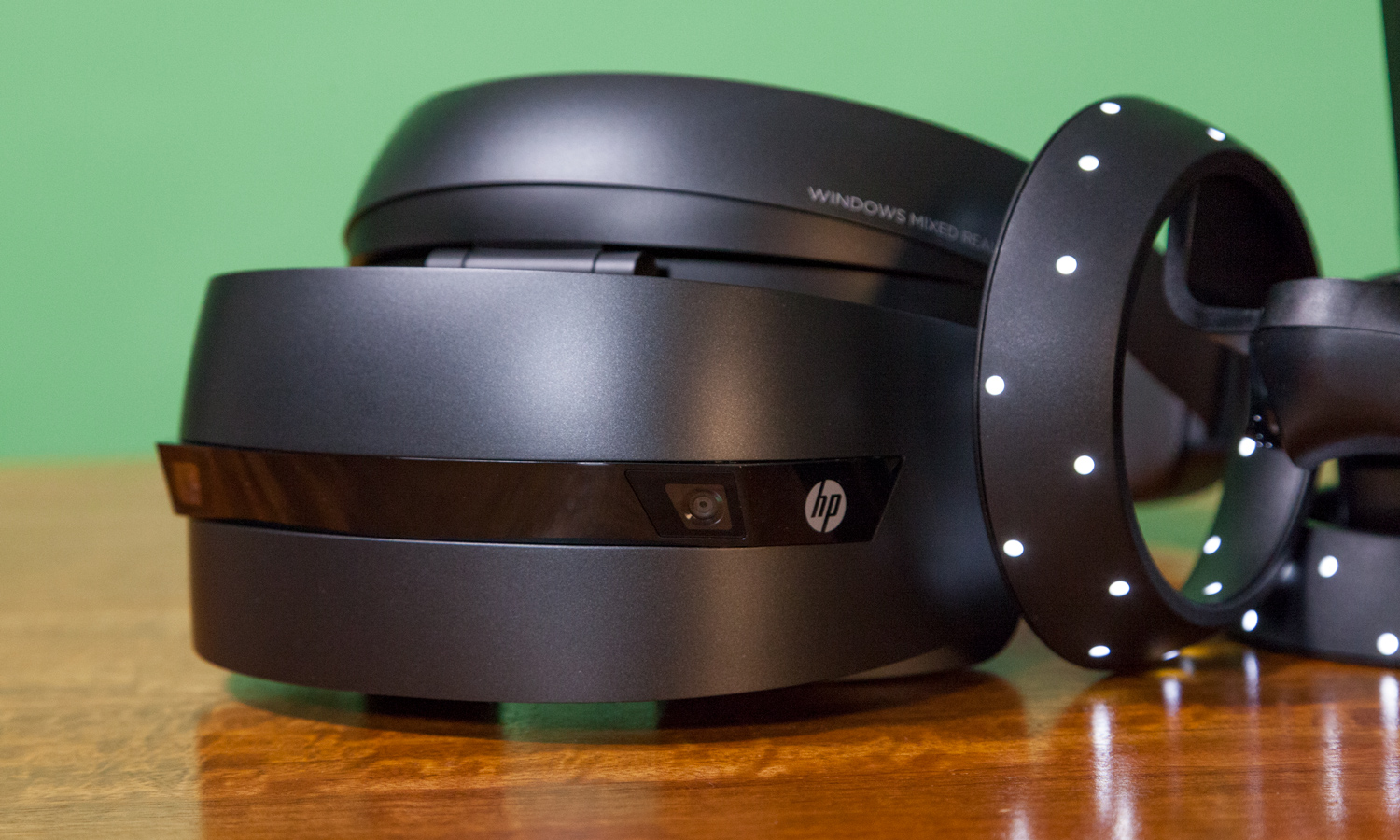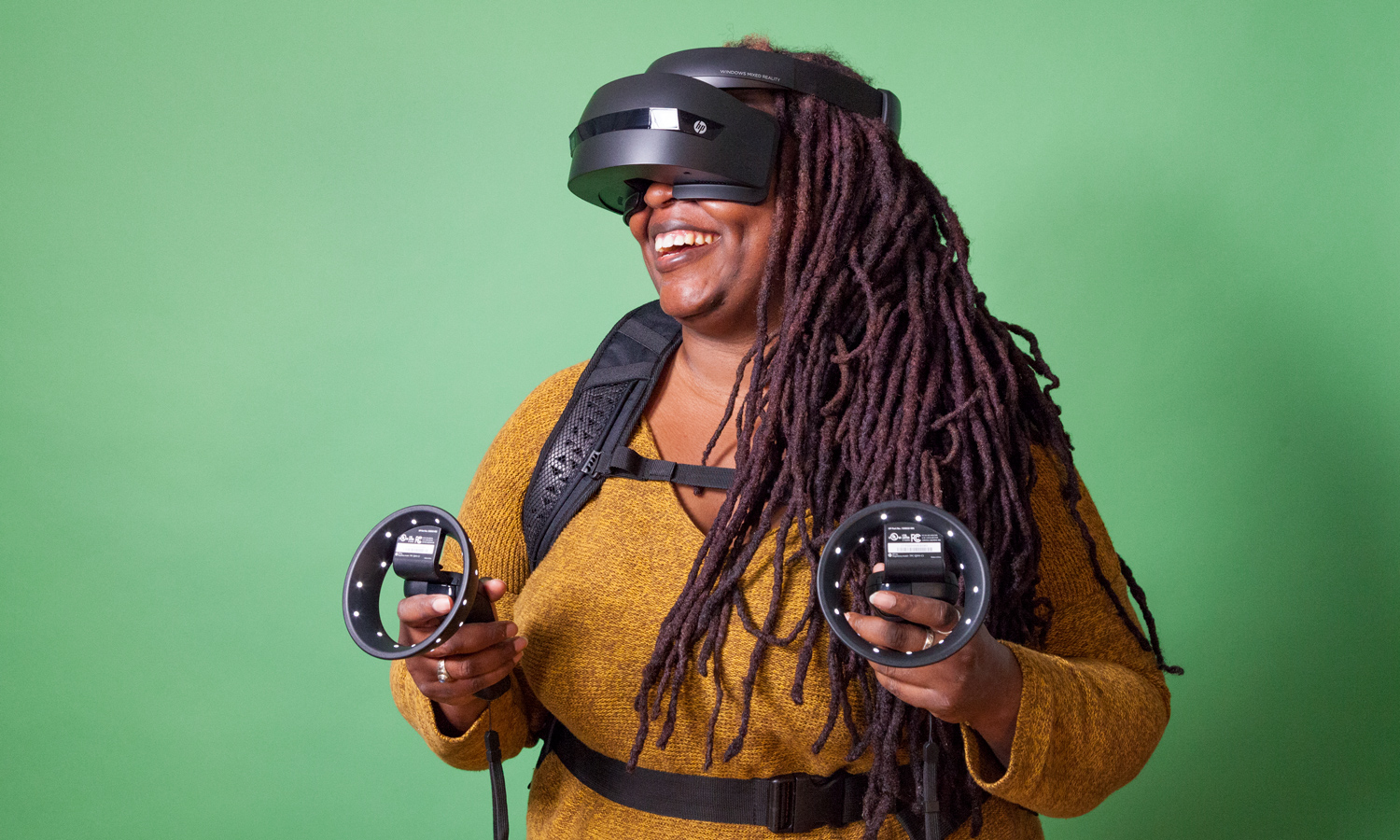Tom's Guide Verdict
The HP Windows Mixed Reality Headset VR1000-100 offers a portable, plug-and-play virtual reality option that can work with integrated and discrete graphics.
Pros
- +
Attractive design with smartly placed ports
- +
Swappable cords
- +
Compatible with a number of systems
Cons
- -
Apps and games are lacking
- -
Noticeable visual differences depending on connected system
- -
A bit heavy
Why you can trust Tom's Guide
HP is the latest company to release a take on a Microsoft Mixed Reality headset, and its entry is dubbed the VR1000-100. But don't let the "mixed reality" designation fool you: The $349 headset isn't capable of supporting augmented reality. Instead, you're getting a fairly portable plug-and-play VR headset that can play nice with both integrated and discrete graphics and that's cheaper than the top-rated Oculus Rift or HTC Vive. Unfortunately, a lack of apps keeps HP's headset from being anything other than a promising work in progress. Still, it's one of the best VR headsets available for use with laptops and desktops using integrated graphics.
Design
At first glance, the HP Mixed Reality headset isn't the most exciting-looking piece of tech. The bulk of the head-mounted display is made of inoffensive black-matte plastic. The embedded cameras reside front and center, encased in a strip of glossy black material. You'll find gray HP logos on the right and top of the headset, and a large 14402 emblem on the left.
There's a pair of air vents along the top of the headset flanking the large, black hinge connecting the headset to the headband. You'll find another set at the bottom surrounding the depression made for your nose. As with the slightly more expensive Acer Windows Mixed Reality AH101 headset, the hinge allows you to flip up the visor when you need to check in on the real world.
Another similarity between the two headsets is the adjustable headband. Both feature a large knob on the back that adjusts the fit of the ring, just like the one found on the PlayStation VR headset. Twist right for a tighter fit, and twist left to loosen the band. A small ring along the left of the band holds a cord that splits into a USB 3.0 cable and HDMI 2.0.
The front and back of the band are padded with cushy foam wrapped in soft-touch material with a noticeable diamond pattern cut into it. The interior sides of the headset are also covered in black foam, but without the fancy covering.
The biggest difference between the two headsets is the placement of a 3.5mm audio jack. Instead of hanging out with the USB 3.0/HDMI cord, the jack is on the bottom right of the headset. It's easier to connect a pair of headphones this way than it is on the Acer AH101, which had me fumbling around the side of my head trying to find the dangling connector. HP lets you adjust the length of the USB 3.0/HDMI cable from 2 feet to 6 feet.
At 28.8 ounces, the 13.3 x 6.9 x 5-inch HP MR headset is a bit heavier and larger than Acer's 25.6-ounce, 7.7 x 4.3 x 2.9-inch AH101.
I wore the HP MR headset for more than an hour in relative comfort, but I'd have rather worn the lighter AH101 from Acer.
Comfort
Windows Mixed Reality headsets are by far my favorite headsets to wear, because I don't have to fight to get all of my hair in the band. I can just pull all my tresses through the top without worrying about a restrictive top band. If I'm wearing a Rift or Vive and have an updo, there's a lot of frustration and maneuvering.

I wore the HP MR headset for more than an hour in relative comfort, but I'd have rather worn the lighter AH101. The HP MR pressed against my face harder than the AH101 did, and I could feel the pressure after 15 minutes. It wasn't uncomfortable, but it was definitely noticeable.
My favorite thing about any of the Windows MR headsets is the flip-up visor. It really came in handy when I had to lunge for my ringing phone. I didn't have to worry about trying to take the headset off; I just flipped up the visor, took a look around the room and found my phone.
Specs
Outside of the design, you're not going to find many differences among most of the Windows MR headsets currently on the market. Just like the AH101, the HP MR headset has a 2.9 x 2-inch LCD panel that provides 1440 x 1440 resolution for each eye and a 100-degree field of view.
In case you were wondering, field of view (FOV) refers to how much of the environment is seen during any given moment. The larger the FOV, the more immersive the experience and the sharper the images. The Vive and the Rift (3.4 x 2-inch panel) each have a 2160 x 1200 OLED display, which works out to 1080 x 1200 per eye with a wider, 110-degree FOV. The PlayStation VR's 5.7-inch RGB OLED screen delivers 1080 x 960 with a 100-degree FOV.
Setup
Who doesn't love the ease of a plug-and-play setup? The 2-in-1 cord meant that all I had to do to get my virtual party started was plug in the HDMI and USB 3.0 connectors to the HP Omen X Compact Desktop PC P1000-010. From there, I went through a 5-minute setup process that checked to see if my system specs were up to snuff and walked me through connecting the controllers.
Next, I had to choose between a seated or standing-room-scale experience. Since I went with the room-scale setup, I was prompted to grab the HP headset and click the Center button on the backpack, as I used the headset to trace the confines of my soon-to-be play area. After that, it was time to dodge virtual bullets and bust ghosts.
However, if you don't feel like carrying a desktop on your back, you can also connect the headset to a laptop or traditional desktop. But, trust me, you're missing out.
Compatibility
Similar to the other Microsoft MR headsets, HP's version requires your PC to meet some minimum specs. First off, you'll need to have the Windows 10 Fall Creators Update installed. You'll also need at least 16GB of RAM, an Nvidia GTX Geforce 965M or AMD Radeon RX 460 GPU, an HDMI 2.0 port or a DisplayPort 1.2, and a USB 3.0 port. A 6th-Generation Intel Core i5 processor is the minimum point of entry for desktops, while laptop owners require at least a 7th-Gen Intel Core i5 processor with Hyper-Threading.
The HP headset can also run on systems outfitted with integrated graphics and an HDMI 1.4 port, like the Asus VivoBook Flip 14. But it will offer a lower FOV (90 degrees) and refresh rate (60Hz) on these lower-powered systems.
Controllers
Whether it's from HPs, Acer, Dell, Lenovo or Samsung, a Windows Mixed Reality headset will have you using the same set of controllers. By virtue of the halo-shaped rings at the top of the devices, the MR controllers marginally resemble the Oculus Touch controllers, but lined with a plethora of lights. That's where the similarity ends.
The HP VR1000-100 controllers are easy enough to use. I was shooting down enemy drones with the best of them in Space Pirate Trainer.
The oblong part of the controller that rests in your hand is pretty comfortable. It's just the right size for gripping and pressing buttons without inducing a hand cramp.
Speaking of buttons, on the top portion of each controller, you'll find a clickable touchpad that has a variety of uses, depending on the game or app. There's also an analog stick and a Menu button. The Windows button sits directly below the Menu button and transports you back to the hub world. Depending on which controller you're holding, the Grab trigger sits directly under your thumb, while the main trigger resides just beneath your index finger.
The controllers are easy enough to use. I was shooting down enemy drones with the best of them in Space Pirate Trainer. And when I was navigating around the fictional "Cliff House" that serves as the home base in Microsoft's mixed-reality world, all it took was a point and click to teleport me to my desired location. When I needed to quickly grab a shuriken in Superhot VR, I just squeezed the Grab button. It was a much more comfortable experience than trying to squeeze the side grips on the Vive controllers.
Interface
While its headsets my have different looks, Microsoft is keeping the virtual interface pretty uniform. As soon as you put on the HP MR headset, you'll find yourself at the Cliff House, a deconstructed take on a house, which has stark white walls and is set atop a grassy cliff overlooking the ocean and Mount Rainier.
You'll notice several virtual windows lining the strategically placed walls. The windows feature Microsoft apps like Store, Hologram, Skype and Edge. You can reposition or resize the windows by pointing and clicking. Pressing the Windows button on either controller will cue up a small Start Menu that mimics the tiles you'd find on a regular Windows PC.
Microsoft's virtual keyboard, more hindrance than boon in other mediums, turns out to be incredibly useful in VR. When I had to enter my password for two-factor authentication, I used the controllers to tap the large, virtual dark-gray keys of the corresponding letters and numbers. Because there's a lot of pointing and clicking going on, typing's not as speedy as it is on a traditional keyboard, but it's fine for shooting off a short email or note. Hopefully, one day we'll be able to use Cortana to dictate messages for us in mixed reality.
Cortana
As it does on the AH101, Cortana makes an appearance on the HP MR headset. If you get tired of the old point-and-click, you can use Microsoft's digital assistant to select objects, launch apps and resize objects, as well as get a quick restaurant recommendation or weather update.
The feature worked really well for those latter tasks, but getting Cortana to perform VR-specific activities was hit or miss. It took several failed attempts before Cortana understood that I wanted her to launch Ghostbusters.
Still, Cortana offers a lot more functionality in the way of voice commands compared to the Samsung Gear VR and the Oculus Voice. The current iteration of Voice features only three commands: Find, Launch and Cancel. However, I found I didn't have to repeat my requests over and over to get an accurate response.
Visual Experience
Thanks to the 1440 x 1440-resolution lenses, the HP MR headset delivers clear, clean images, but they're still not as good as what you'd see on either the Vive or the Rift. For example, the blood splatter I created from shooting zombies in Arizona Sunshine lacked definition on the HP MR headset compared to the almost-nauseatingly realistic spurts I saw on the Vive and Oculus. If I turned my head a bit too fast, there was some noticeable blurring.
But it wasn't all bad. HP's headset did an excellent job of keeping track of the motion controllers, and I didn't lose any of my play area as I moved around my virtual world.
Thanks to the 1440 x 1440-resolution lenses, the HP MR headset delivers clear, clean images, but they're still not as good as what you'd see on the Vive or the Rift.
That's not to say there weren't a few hiccups. I almost became zombie food when my hand ghosted through the gun I was reaching for to hold off the undead horde. After a few frantic swipes, the headset reacted and let me grab the weapon. It's a little spotty, but not unreasonably so.
Exploring the Tiers of VR
Depending on the laptop or desktop you plug the HP Mixed Reality headset into, the device will render images with the optimal refresh rate of 90 Hertz or the minimum 60Hz rate. It all depends on whether your GPU is integrated or discrete. When I played Space Pirate Trainer on the HP Omen X VR Backpack, that machine's Nvidia GTX 1080 GPU ensured that the lasers firing from the enemy drones were nice and crisp. The same went for the resulting explosions when I scored a direct hit on one of the offending bots.
When I switched over to the Acer Swift 3 and its integrated Intel HD Graphics 620 GPU, the lower refresh rate only slightly affected the action. Details in the world were muddier than the 90Hz iteration. I also lost some of the immersion factor thanks to the narrower, 90-degree field of view.
Games and Apps
Microsoft has a lot of catching up to do on content, especially when compared to Oculus and HTC. To date, there are only 49 apps in the Mixed Reality section of the Microsoft Store. Most of the apps have been ported over from the Oculus or SteamVR libraries. By contrast, the Oculus store boasts more than 2,000 apps and games, while the Vive and PS VR have more than 300 and 100 pieces of content, respectively.
Microsoft is hoping to counteract its dearth of content by tapping into the SteamVR Store, recently beta-launching the Windows Mixed Reality for Steam VR app. The free early access app lets you play SteamVR apps on Windows MR headsets. Since the app is currently in early access, some bugs still need to be worked out.
When I tried using the app to access SteamVR, I received several messages notifying me that the HP MR headset wasn't recognized. I had to dig through the Steam forums to find the solution, though after that, I was able to play the space combat title Elite Dangerous, which ran smoothly. However, the Project Cars VR game had consistent rendering problems, which made it unplayable.

The Steam forums are full of users complaining of the same issue, as well as low frame rates and inconsistent performance. It's nice to have the option to play SteamVR apps, but I wish it were a smoother experience out the box.
Bottom Line
I'm still not sold on Microsoft's Mixed Reality headsets. For one, they don't actually do mixed reality — there's no virtual content imposed on the real world to be found here — and it's misleading to suggest otherwise.
In the case of the HP Windows Mixed Reality headset, for $349, you get a headset that provides a solid VR experience, despite the lack of content. HP made some smart design decisions with the embedded audio jack and quick-change cables. It makes the plug-and-play experience that much easier.
You could opt instead for the $297 Acer Windows Mixed Reality AH101 headset, which is significantly cheaper, lighter, more comfortable and more colorful. But until Microsoft works out all the bugs with the SteamVR compatibility, I'm going to recommend the $399 Oculus Rift. It delivers a premier VR experience and has a vast and rapidly growing library of content that gives you the best of the technology.
However, with the Rift, you do have to do a bit more setup to correctly place the external sensors. You'll also require a more powerful laptop or desktop in order to get the Rift to play nice.
Overall, if you're looking for an inexpensive, PC-powered virtual reality headset that can work with both integrated and discrete graphics, the HP Windows Mixed Reality Headset VR1000-100 is a good choice.
Credit: Tom's Guide
Sherri L. Smith has been cranking out product reviews for Laptopmag.com since 2011. In that time, she's reviewed more than her share of laptops, tablets, smartphones and everything in between. The resident gamer and audio junkie, Sherri was previously a managing editor for Black Web 2.0 and contributed to BET.Com and Popgadget.


